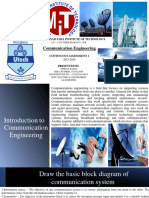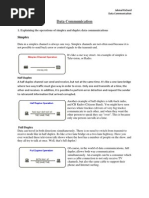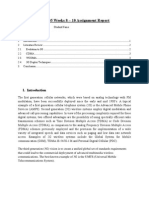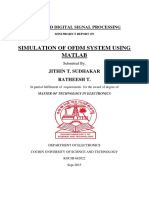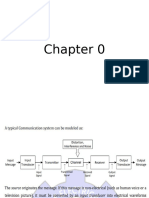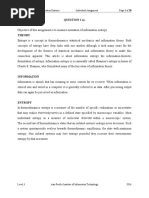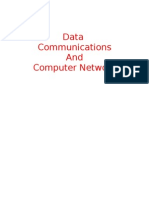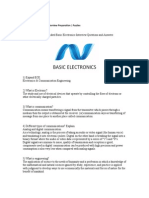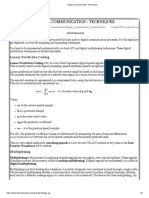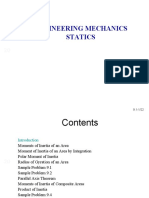Assignments: Communication Technology (MC 0018)
Uploaded by
amitavamudiAssignments: Communication Technology (MC 0018)
Uploaded by
amitavamudiAssignments
Communication Technology (MC 0018)
Amitava Mudi,
MCA – 4 th
Semester, Roll Number: 510545511, LC Code 1608
Assignments MCA Semester 4 1
Table of Contents
1 Assignment Set 1..........................................................3
1.1 Describe the principles and layers of digital communication
systems.......................................................................................3
1.2 With respect to Time Division Multiplexing discuss the following:. 4
1.3 Explain the theory of Pulse Code Modulation (PCM)......................4
1.4 Write about LOS propagation on Flat Earth, Effects of
atmosphere, and LOS Microwave systems..................................5
1.5 Describe Space Craft Subsystems with respect to Satellite
communications..........................................................................6
1.6 Explain in detail the structure and characteristics of optical fibers
with emphasis on their important parameters............................6
2 Assignments Set 2........................................................8
2.1 Write about ..................................................................................8
2.2 An audio signal consists of a sinusoidal term v(t) = 3 cos 3140t. 9
2.3 Explain in detail Frequency Shift Keying with Bell – type 103 FSK
Modem......................................................................................10
2.4 Write about:................................................................................11
2.5 Write about the following with respect to:..................................12
2.6 Explain the principle of operation and characteristics of the
following:..................................................................................13
Assignments MCA Semester 4 2
1 Assignment Set 1
1.1 Describe the principles and layers of digital communication
systems.
There are four layer of digital communication;
¾ Protocol - In the field of telecommunications, a communications
protocol is the set of standard rules for data representation, signaling,
authentication and error detection required to send information over a
communications channel. An example of a simple communications
protocol adapted to voice communication is the case of a radio
dispatcher talking to mobile stations. Communication protocols for
digital computer network communication have features intended to
ensure reliable interchange of data over an imperfect communication
channel. Communication protocol is basically following certain rules so
that the system works properly.
¾ Coding - In digital communications, a channel code is a broadly used
term mostly referring to the forward error correction code and bit
interleaving in communication and storage where the communication
media or storage media is viewed as a channel. The channel code is
used to protect data sent over it for storage or retrieval even in the
presence of noise (errors).
Sometimes channel coding also refers to other physical layer issues
such as digital modulation, line coding, clock recovery, pulse shaping,
channel equalization, bit synchronization, training sequences, etc.
Channel coding is distinguished from source coding, i.e., digitalization
of analog message signals and data compression.
¾ Format – is responsible for adding additional information about the
message such as who is it for, how long it is, and where it ends.
Format also provides framing and additional information that helps the
receiver determine if the message, as received, contain any errors.
¾ Modulation - Modulation is the process of transforming a message
signal to make it easier to work with. It usually involves varying one
waveform in relation to another waveform. In telecommunications,
modulation is used to convey a message, or a musician may modulate
the tone from a musical instrument by varying its volume, timing and
pitch. In radio communications for instance, electrical signals are best
received when the transmitter and receiver are tuned to resonance.
Therefore keeping the frequency content of the message signal as
close as possible to the resonant frequency of the two is ideal. Often a
high-frequency sinusoid waveform is used as carrier signal to convey a
lower frequency signal. The three key parameters of a sine wave are
its amplitude ("volume"), its phase ("timing") and its frequency
Assignments MCA Semester 4 3
("pitch"), all of which can be modified in accordance with a low
frequency information signal to obtain the modulated signal.
A device that performs modulation is known as a modulator and a
device that performs the inverse operation of modulation is known as
a demodulator (sometimes detector or demod). A device that can do
both operations is a modem (short for "Modulator-Demodulator").
1.2 With respect to Time Division Multiplexing discuss the
following:
¾ T1 Digital Systems - Digital signal 1, also known as T1, is a T-carrier
signaling scheme devised by Bell Labs. DS1 is a widely used standard
in telecommunications all over the world. A DS1 circuit is made up of
twenty-four 8-bit channels (also known as timeslots or DS0s), each
channel being a 64 kbit/s DS0 multiplexed carrier circuit. A DS1 is also
a full-duplex circuit, which means the circuit transmits and receives
1.544 Mbit/s concurrently. A total of 1.536 Mbit/s of bandwidth is
achieved by sampling each of the twenty-four 8-bit DS0s 8000 times
per second. This sampling is referred to as 8-kHz sampling. An
additional 8 kbit/s of overhead is obtained from the placement of one
framing bit.
¾ Signaling - In a telecommunications network, the information
exchange concerning the establishment and control of a connection
and the management of the network is called signaling. In the public
switched telephone network, (PSTN), in-band signaling is the exchange
of signaling (call control) information within the same channel that the
telephone call itself is using. An example is DTMF 'Dual-Tone multi-
frequency' signaling, which is used on most telephone lines to
exchanges.
Out-of-band signaling is telecommunication signaling (exchange of
information in order to control a telephone call) that is done on a
channel that is dedicated for the purpose and separate from the
channels used for the telephone call. Out-of-band signaling is used in
Signaling System #7 (SS7), the standard for signaling among
exchanges that has controlled most of the world's phone calls for
several years.
1.3 Explain the theory of Pulse Code Modulation (PCM).
Pulse-code modulation (PCM) is a digital representation of an analog signal
where the magnitude of the signal is sampled regularly at uniform
intervals, then quantized to a series of symbols in a numeric (usually
binary) code. PCM has been widely used in digital telephone systems.
Assignments MCA Semester 4 4
A sine wave is sampled and quantized for PCM. The sine wave is sampled
at regular intervals. For each sample, one of the available values is chosen
by some algorithm, usually the floor function is used. This produces a fully
discrete representation of the input signal (shaded area) that can be easily
encoded as digital data for storage or manipulation. This is modulation of
the input signal.
To produce output from the sampled data, the procedure of modulation is
applied in reverse. After each sampling period has passed, the next value
is read and a signal is shifted to the new value. As a result of these
transitions, the signal will have a significant amount of high-frequency
energy. To smooth out the signal and remove these undesirable aliasing
frequencies, the signal would be passed through analog filters that
suppress energy outside the expected frequency range.
1.4 Write about LOS propagation on Flat Earth, Effects of
atmosphere, and LOS Microwave systems
Line-of-sight propagation refers to electro-magnetic radiation or acoustic
wave propagation. Electromagnetic transmission includes light emissions
traveling in a straight line. The rays or waves may be diffracted, refracted,
reflected, or absorbed by atmosphere and obstructions with material and
generally cannot travel over the horizon or behind obstacles.
Especially radio signals, like all electromagnetic radiation including light
emissions, travel in straight lines. At low frequencies (below approximately
2 MHz or so) these signals travel as ground waves, which follow the Earth's
curvature due to diffraction with the layers of atmosphere. This enables
AM radio signals in low-noise environments to be received well after the
transmitting antenna has dropped below the horizon. Additionally,
frequencies between approximately 1 and 30 MHz, can be reflected by the
F1/F2 Layer, thus giving radio transmissions in this range a potentially
global reach (see shortwave radio), again along multiply deflected straight
lines. The effects of multiple diffraction or reflection lead to
macroscopically "quasi-curved paths".
However, at higher frequencies and in lower levels of the atmosphere,
neither of these effects applies. Thus any obstruction between the
transmitting antenna and the receiving antenna will block the signal, just
like the light that the eye may sense. Therefore, as the ability to visual
sight a transmitting antenna (with regards to the limitations of the eye's
resolution) roughly corresponds with the ability to receive a signal from it,
the propagation characteristic of high-frequency radio is called "line-of-
sight". The farthest possible point of propagation is referred to as the
"radio horizon".
In practice, the propagation characteristics of these radio waves vary
substantially depending on the exact frequency and the strength of the
transmitted signal (a function of both the transmitter and the antenna
Assignments MCA Semester 4 5
characteristics). Broadcast FM radio, at comparatively low frequencies of
around 100 MHz, easily propagates through buildings and forests.
1.5 Describe Space Craft Subsystems with respect to Satellite
communications.
Low Noise Frequency Down
Band Pass Filter Pre-amplifier Power Amplifier
Amplifier(LNA) Converter
Local Oscillator
Figure 1 Transponder
Communication subsystem is a major subsystem in a satellite. The
satellite acts as a repeater & hence needs and transmitter and receiver.
The transmitter – receiver set is known as “transponder”. A
communication satellite has one or more antennas & many transponders.
A typical single conversion type transponder is as shown in the block
diagram above.
Antenna subsystem:
This is a part of communication subsystem. Satellite has very complex
antenna system and is designed to cover the earth surface. Antenna is
designed to focus to the distant desired location. It is highly directional.
High efficiency of the antenna ensures that lower cost of equipment at the
receiving end as well as higher capacity of transmission.
1.6 Explain in detail the structure and characteristics of optical
fibers with emphasis on their important parameters.
Structure and Characteristics of Optical Fibers
An optical fiber is a cylindrical dielectric waveguide (no conducting
waveguide) that transmits light along its axis, by the process of total
internal reflection. The fiber consists of a core surrounded by a cladding
layer, both of which are made of dielectric materials. To confine the optical
signal in the core, the refractive index of the core must be greater than
that of the cladding. The boundary between the core and cladding may
either be abrupt, in step-index fiber, or gradual, in graded-index fiber.
An optical fiber consists of a core, cladding, and a buffer (a protective
outer coating), in which the cladding guides the light along the core by
using the method of total internal reflection. The core and the cladding
(which has a lower-refractive-index) are usually made of high-quality silica
glass, although they can both be made of plastic as well. Connecting two
optical fibers is done by fusion splicing or mechanical splicing and requires
Assignments MCA Semester 4 6
special skills and interconnection technology due to the microscopic
precision required to align the fiber cores.
Figure 2 Optical fiber cable
Important parameters of Optical Fibers
Following are the important parameters of fibers
1. Numerical Aperture
2. Index difference (δ )
3. Normalized frequency or V number
4. Attenuation of the fiber
Assignments MCA Semester 4 7
2 Assignments Set 2
2.1 Write about
Quantization
Quantization is the procedure of constraining something from a continuous
set of values (such as the real numbers) to a discrete set (such as the
integers).
In digital signal processing, quantization is the process of approximating
("mapping") a continuous range of values (or a very large set of possible
discrete values) by a relatively small ("finite") set of ("values which can
still take on continuous range") discrete symbols or integer values. For
example, rounding a real number in the interval [0,100] to an integer
In other words, quantization can be described as a mapping that
represents a finite continuous interval I = [a, b] of the range of a
continuous valued signal, with a single number c, which is also on that
interval. For example, rounding to the nearest integer (rounding ½ up)
replaces the interval [c − .5,c + .5) with the number c, for integer c. After
that quantization we produce a finite set of values which can be encoded
by binary techniques for example.
In signal processing, quantization refers to approximating the output by
one of a discrete and finite set of values, while replacing the input by a
discrete set is called discretization, and is done by sampling: the resulting
sampled signal is called a discrete signal (discrete time), and need not be
quantized (it can have continuous values). To produce a digital signal
(discrete time and discrete values), one both samples (discrete time) and
quantizes the resulting sample values (discrete values).
Time Division Multiplexing
Time-division multiplexing (TDM) is a type of digital or (rarely) analogue
multiplexing in which two or more signals or bit streams are transferred
apparently simultaneously as sub-channels in one communication channel,
but are physically taking turns on the channel. The time domain is divided
into several recurrent timeslots of fixed length, one for each sub-channel.
A sample byte or data block of sub-channel 1 is transmitted during
timeslot 1, sub-channel 2 during timeslot 2, etc. One TDM frame consists
of one timeslot per sub-channel. After the last sub-channel the cycle starts
all over again with a new frame, starting with the second sample, byte or
data block from sub-channel 1, etc.
Vocoders
A vocoder is a combination of the words voice and encoder) is an analysis /
synthesis system, mostly used for speech. In the encoder, the input is
passed through a multiband filter, each band is passed through an
Assignments MCA Semester 4 8
envelope follower, and the control signals from the envelope followers are
communicated to the decoder. The decoder applies these (amplitude)
control signals to corresponding filters in the (re)synthesizer.
It was originally developed as a speech coder for telecommunications
applications in the 1930s, the idea being to code speech for transmission.
Its primary use in this fashion is for secure radio communication, where
voice has to be encrypted and then transmitted. The advantage of this
method of "encryption" is that no 'signal' is sent, but rather envelopes of
the band pass filters. The receiving unit needs to be set up in the same
channel configuration to re-synthesize a version of the original signal
spectrum. The vocoder as both hardware and software has also been used
extensively as an electronic musical instrument.
2.2 An audio signal consists of a sinusoidal term v(t) = 3 cos
3140t.
¾ (a) Find the signal to quantization noise ratio using 10-bit PCM.
¾ (b) How many bits are required to achieve a signal to quantization
noise ratio of at least 40dB?
The signal to quantization ration is given by the equation
[S0/Nq]db = 10 log10 [S0/Nq] = 10 log10 22n = 6N
Where S0 ~= Si = 32/2 = 4.5 watts. (‘.’ The maximum amplitude = 3V)
Nq = S2 / 12; where S is the step size.
Since maximum amplitude is 3V, the swing of the signal is from -3 to +3
volts, that is 6 V.
Moreover S = (VH-VL)/M = (VH-VL)/2N where N is the number of bits used
for encoding.
Since N = 10, & VH-VL = 6 we have
S = 6/210 = 5.86 X 10-3 and Nq = (5.6 X 10-3)/12 = 4.88x10-7
SNR = 4.5/(4.88x10-7) = 9.22x106
SNR in dB = 10 log (9.22x106) = 69.6 dB
So/ (S2 / 12) < 104
With So ~= Si = 4.5 we have
S < ((12x4.5)/104)1/2 = 7.34 x 10-2
With S = 6/2N where N is the number of bits required for quantization, We
have to choose N such a way that
S < 7.34 x 10-2
.‘. 2N > 81.6
Assignments MCA Semester 4 9
With N = 6, we have 64 levels; with N = 7 we have 128 levels which
satisfies the condition. Therefore we need to encode as 7 bits to
achieve the required SNR of not less than 40 dB.
2.3 Explain in detail Frequency Shift Keying with Bell – type 103
FSK Modem
Frequency-shift keying (FSK) is a frequency modulation scheme in which
digital information is transmitted through discrete frequency changes of a
carrier wave. The simplest FSK is binary FSK (BFSK). BFSK literally implies
using a couple of discrete frequencies to transmit binary (0s and 1s)
information. With this scheme, the "1" is called the mark frequency and
the "0" is called the space frequency.
Figure 3 FSK example
Source Computer FSK Modem Telephone Channel FSK Modem Destination Computer
Digital Data Dial up Phone Line Digital data
Figure 4 Computer communication using FSK signaling
Table 1 Standard frequencies used for Bell-103 modem
Originate Modem Answer Modem
Transmit frequencies
Binary 1 F=1270 Hz F=2225 Hz
Binary 0 F=1070 Hz F=2025 Hz
Assignments MCA Semester 4 10
Originate Modem Answer Modem
Receive frequencies
Binary 1 F=2225 Hz F=1270 Hz
Binary 0 F=2025 Hz F=1070 Hz
2.4 Write about:
Antennas and Associated Equipments
A communications satellite (sometimes abbreviated to COMSAT) is an
artificial satellite stationed in space for the purpose of
telecommunications. Modern communications satellites use a variety of
orbits including geostationary orbits, Molniya orbits, other elliptical orbits
and low (polar and non-polar) Earth orbits.
For fixed (point-to-point) services, communications satellites provide a
microwave radio relay technology complementary to that of submarine
communication cables. They are also used for mobile applications such as
communications to ships, vehicles, planes and hand-held terminals, and
for TV and radio broadcasting, for which application of other technologies,
such as cable, is impractical or impossible.
Satellite has very complex antenna system and is designed to cover the
earth surface. Antenna is designed to focus to the distant desired location.
It is highly directional. High efficiency of the antenna ensures that lower
cost of equipment at the receiving end as well as higher capacity of
transmission.
The receiver and transmitter associated with the antenna are called
transponders.
Multiplexing and Modulation techniques
¾ Modulation
♦ Pulse-amplitude modulation (PAM)
♦ Pulse-width modulation (PWM)
♦ Pulse-position modulation (PPM)
Analog-over-digital methods:
♦ Pulse-code modulation (PCM)
♦ Differential PCM (DPCM)
♦ Adaptive DPCM (ADPCM)
♦ Delta modulation (DM or Δ-modulation)
♦ Sigma-delta modulation (∑Δ)
Assignments MCA Semester 4 11
♦ Continuously variable slope delta modulation (CVSDM), also called
Adaptive-delta modulation (ADM)
♦ Pulse-density modulation (PDM)
¾ Multiplexing
♦ FDM - Frequency-division multiplexing (FDM) is a form of signal
multiplexing which involves assigning non-overlapping frequency
ranges to different signals or to each "user" of a medium.
♦ TDM - Time-division multiplexing (TDM) is a type of digital or
(rarely) analogue multiplexing in which two or more signals or bit
streams are transferred apparently simultaneously as sub-
channels in one communication channel, but are physically taking
turns on the channel. The time domain is divided into several
recurrent timeslots of fixed length, one for each sub-channel. A
sample byte or data block of sub-channel 1 is transmitted during
timeslot 1, sub-channel 2 during timeslot 2, etc. One TDM frame
consists of one timeslot per sub-channel. After the last sub-
channel the cycle starts all over again with a new frame, starting
with the second sample, byte or data block from sub-channel 1,
etc.
Tropospheric Forward Scatter Systems
At VHF and higher frequencies, small variation (turbulence) in the density
of the atmosphere at a height of around 6 miles (10 km) can scatter some
of the normally line-of-sight beam of radio frequency energy back toward
the ground, allowing over-the-horizon communication between stations as
far as 500 miles (800 km) apart.
2.5 Write about the following with respect to:
Advantages of Optical Fiber Communications
¾ Immunity to electromagnetic interference, including nuclear
electromagnetic pulses (although fiber can be damaged by alpha and
beta radiation).
¾ High electrical resistance, making it safe to use near high-voltage
equipment or between areas with different earth potentials.
¾ Lighter weight—important, for example, in aircraft.
¾ No sparks—important in flammable or explosive gas environments.
¾ Not electromagnetically radiating (low loss), and difficult to tap
without disrupting the signal—important in high-security
environments.
¾ Much smaller cable size—important where pathway is limited, such as
networking an existing building, where smaller channels can be drilled
and space can be saved in existing cable ducts and trays.
Assignments MCA Semester 4 12
Structure and Characteristics of Optical Fibers
An optical fiber consists of a core, cladding, and a buffer (a protective
outer coating), in which the cladding guides the light along the core by
using the method of total internal reflection. The core and the cladding
(which has a lower-refractive-index) are usually made of high-quality silica
glass, although they can both be made of plastic as well. Connecting two
optical fibers is done by fusion splicing or mechanical splicing and requires
special skills and interconnection technology due to the microscopic
precision required to align the fiber cores.
Important parameters of Optical Fibers
Following are the important parameters of fibers
5. Numerical Aperture
6. Index difference (δ )
7. Normalized frequency or V number
8. Attenuation of the fiber
2.6 Explain the principle of operation and characteristics of the
following:
Light Emitting Diode
A light-emitting diode (LED) is a semiconductor light source. LEDs are used
as indicator lamps in many devices, and are increasingly used for lighting.
Introduced as a practical electronic component in 1962, early LEDs
emitted low-intensity red light, but modern versions are available across
the visible, ultraviolet and infrared wavelengths, with very high brightness.
The LED is based on the semiconductor diode. When a diode is forward
biased (switched on), electrons are able to recombine with holes within the
device, releasing energy in the form of photons. This effect is called
electroluminescence and the color of the light (corresponding to the
energy of the photon) is determined by the energy gap of the
semiconductor. An LED is usually small in area (less than 1 mm2), and
integrated optical components are used to shape its radiation pattern and
assist in reflection.
Laser
Light Amplification by Stimulated Emission of Radiation, LASER (laser), is a
mechanism for emitting light within the electromagnetic radiation region
of the spectrum, via the process of stimulated emission. The emitted laser
light is (usually) a spatially coherent, narrow low-divergence beam, that
can be manipulated with lenses. In laser technology, “coherent light”
denotes a light source that produces (emits) light of in-step waves of
Assignments MCA Semester 4 13
identical frequency and phase. The laser’s beam of coherent light
differentiates it from light sources that emit incoherent light beams, of
random phase varying with time and position; whereas the laser light is a
narrow-wavelength electromagnetic spectrum monochromatic light; yet,
there are lasers that emit a broad spectrum light, or simultaneously, at
different wavelengths.
Photo Detectors
These are used at the receiving end in the communication system. There
are two types of light detectors used
¾ Photo diodes - A photodiode is a type of photo detector capable of
converting light into either current or voltage, depending upon the
mode of operation.
Photodiodes are similar to regular semiconductor diodes except that
they may be either exposed (to detect vacuum UV or X-rays) or
packaged with a window or optical fiber connection to allow light to
reach the sensitive part of the device. Many diodes designed for use
specifically as a photodiode will also use a PIN junction rather than the
typical PN junction.
¾ Avalanche photo diodes – An avalanche photodiode (APD) is a highly
sensitive semiconductor electronic device that exploits the
photoelectric effect to convert light to electronic signal. APDs can be
thought of as photo detectors that provide a built-in first stage of gain
through avalanche multiplication. From a functional standpoint, they
can be regarded as the semiconductor analogue to photomultipliers.
By applying a high reverse bias voltage (typically 100-200 V in silicon),
APDs show an internal current gain effect (around 100) due to impact
ionization (avalanche effect). However, some silicon APDs employ
alternative doping and bevelling techniques compared to traditional
APDs that allow greater voltage to be applied (> 1500 V) before
breakdown is reached and hence a greater operating gain (> 1000). In
general, the higher the reverse voltage the higher the gain.
Assignments MCA Semester 4 14
You might also like
- Communications 2: Modulation and Coding Techniques100% (2)Communications 2: Modulation and Coding Techniques9 pages
- Simulation of Digital Communication Systems Using MatlabFrom EverandSimulation of Digital Communication Systems Using Matlab3.5/5 (22)
- CH 9 Notes - Relationships Between Points, Lines, and PlanesNo ratings yetCH 9 Notes - Relationships Between Points, Lines, and Planes9 pages
- Cs9251 Mobile Computing University Questions With Answers97% (31)Cs9251 Mobile Computing University Questions With Answers26 pages
- Communication Systems (Digital Communication)No ratings yetCommunication Systems (Digital Communication)129 pages
- Pulse-Code Modulation (PCM) Is A Method Used ToNo ratings yetPulse-Code Modulation (PCM) Is A Method Used To8 pages
- Activity No. 3 Pulse Code Modulation: Perez, Patricia Grace P. Student Number: 201912327 Bscpe 3-1 Cpen 80No ratings yetActivity No. 3 Pulse Code Modulation: Perez, Patricia Grace P. Student Number: 201912327 Bscpe 3-1 Cpen 805 pages
- The Work Presented Below Is Solely Based Upon Our Research and We Ought Responsibility For It' AuthenticityNo ratings yetThe Work Presented Below Is Solely Based Upon Our Research and We Ought Responsibility For It' Authenticity22 pages
- Basic Electronic Interview Questions and AnswersNo ratings yetBasic Electronic Interview Questions and Answers18 pages
- Rohde and Shwarz LTE - TMs - and - BeamformingNo ratings yetRohde and Shwarz LTE - TMs - and - Beamforming25 pages
- Study of Turbo Coded OFDM Over Fading Channel: Suchita Chatterjee, Mangal SinghNo ratings yetStudy of Turbo Coded OFDM Over Fading Channel: Suchita Chatterjee, Mangal Singh5 pages
- Form 4 Computer Studies All Topics Questions and AnswersNo ratings yetForm 4 Computer Studies All Topics Questions and Answers32 pages
- Advanced Modulation Techniques: Telecom Titans: Building the Connected World, #2From EverandAdvanced Modulation Techniques: Telecom Titans: Building the Connected World, #2No ratings yet
- Signal Integrity: From High-Speed to Radiofrequency ApplicationsFrom EverandSignal Integrity: From High-Speed to Radiofrequency ApplicationsNo ratings yet
- Principles of Communications Networks and SystemsFrom EverandPrinciples of Communications Networks and SystemsNevio BenvenutoNo ratings yet
- Overview of Zirconia Application As Denture Base Material Substituting For MetalNo ratings yetOverview of Zirconia Application As Denture Base Material Substituting For Metal4 pages
- Beamforming in Multi-Path Channels at 28 GHZ: Creating The Antenna ElementsNo ratings yetBeamforming in Multi-Path Channels at 28 GHZ: Creating The Antenna Elements7 pages
- 201-09.1 Distributed Forces - Moments of InertiaNo ratings yet201-09.1 Distributed Forces - Moments of Inertia22 pages
- Projection of Planes Question Bank and Solutions33% (3)Projection of Planes Question Bank and Solutions6 pages
- Corona Charging of Polymers: Recent Advances On Constant Current ChargingNo ratings yetCorona Charging of Polymers: Recent Advances On Constant Current Charging12 pages
- Wind Energy - 2024 - Sharma - ExaWind Open‐source CFD for hybrid‐RANS LES geometry‐resolved wind turbine simulations inNo ratings yetWind Energy - 2024 - Sharma - ExaWind Open‐source CFD for hybrid‐RANS LES geometry‐resolved wind turbine simulations in33 pages
- Eigenvectors and Eigenvalues: Explained VisuallyNo ratings yetEigenvectors and Eigenvalues: Explained Visually9 pages
- Parul University: Q.1 Objective Type Questions - (All Are Compulsory) (Each of One Mark)No ratings yetParul University: Q.1 Objective Type Questions - (All Are Compulsory) (Each of One Mark)2 pages
- The Aircraft Engineer: WX M' y A Sinh /SX + B Cosh Yjc + - +No ratings yetThe Aircraft Engineer: WX M' y A Sinh /SX + B Cosh Yjc + - +1 page
- Communications 2: Modulation and Coding TechniquesCommunications 2: Modulation and Coding Techniques
- Simulation of Digital Communication Systems Using MatlabFrom EverandSimulation of Digital Communication Systems Using Matlab
- CH 9 Notes - Relationships Between Points, Lines, and PlanesCH 9 Notes - Relationships Between Points, Lines, and Planes
- Cs9251 Mobile Computing University Questions With AnswersCs9251 Mobile Computing University Questions With Answers
- Activity No. 3 Pulse Code Modulation: Perez, Patricia Grace P. Student Number: 201912327 Bscpe 3-1 Cpen 80Activity No. 3 Pulse Code Modulation: Perez, Patricia Grace P. Student Number: 201912327 Bscpe 3-1 Cpen 80
- The Work Presented Below Is Solely Based Upon Our Research and We Ought Responsibility For It' AuthenticityThe Work Presented Below Is Solely Based Upon Our Research and We Ought Responsibility For It' Authenticity
- Study of Turbo Coded OFDM Over Fading Channel: Suchita Chatterjee, Mangal SinghStudy of Turbo Coded OFDM Over Fading Channel: Suchita Chatterjee, Mangal Singh
- Form 4 Computer Studies All Topics Questions and AnswersForm 4 Computer Studies All Topics Questions and Answers
- Advanced Modulation Techniques: Telecom Titans: Building the Connected World, #2From EverandAdvanced Modulation Techniques: Telecom Titans: Building the Connected World, #2
- Signal Integrity: From High-Speed to Radiofrequency ApplicationsFrom EverandSignal Integrity: From High-Speed to Radiofrequency Applications
- Principles of Communications Networks and SystemsFrom EverandPrinciples of Communications Networks and Systems
- Error-Correction on Non-Standard Communication ChannelsFrom EverandError-Correction on Non-Standard Communication Channels
- Overview of Zirconia Application As Denture Base Material Substituting For MetalOverview of Zirconia Application As Denture Base Material Substituting For Metal
- Beamforming in Multi-Path Channels at 28 GHZ: Creating The Antenna ElementsBeamforming in Multi-Path Channels at 28 GHZ: Creating The Antenna Elements
- Corona Charging of Polymers: Recent Advances On Constant Current ChargingCorona Charging of Polymers: Recent Advances On Constant Current Charging
- Wind Energy - 2024 - Sharma - ExaWind Open‐source CFD for hybrid‐RANS LES geometry‐resolved wind turbine simulations inWind Energy - 2024 - Sharma - ExaWind Open‐source CFD for hybrid‐RANS LES geometry‐resolved wind turbine simulations in
- Parul University: Q.1 Objective Type Questions - (All Are Compulsory) (Each of One Mark)Parul University: Q.1 Objective Type Questions - (All Are Compulsory) (Each of One Mark)
- The Aircraft Engineer: WX M' y A Sinh /SX + B Cosh Yjc + - +The Aircraft Engineer: WX M' y A Sinh /SX + B Cosh Yjc + - +




